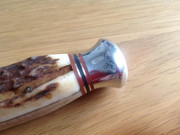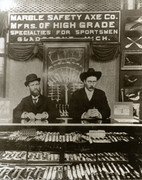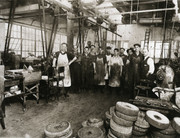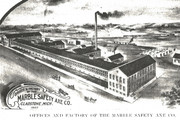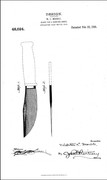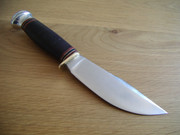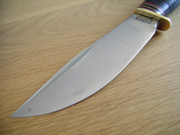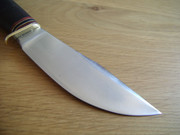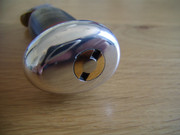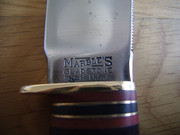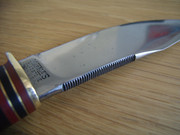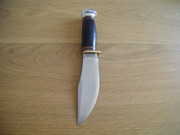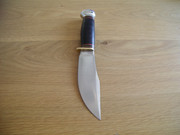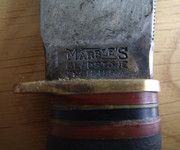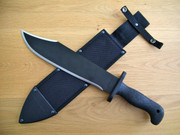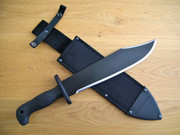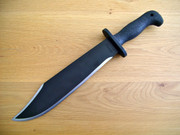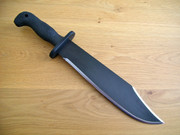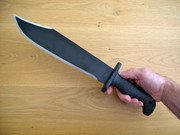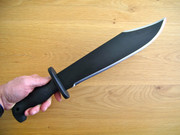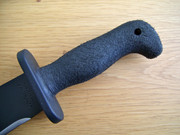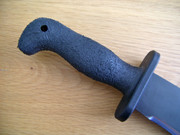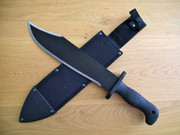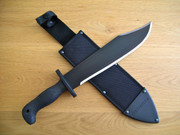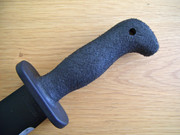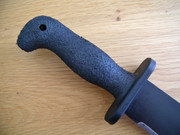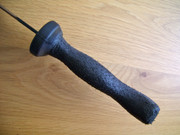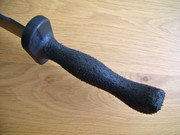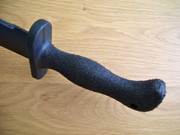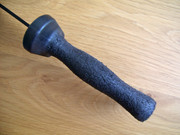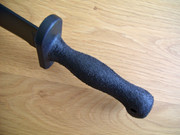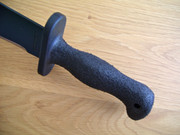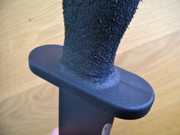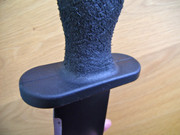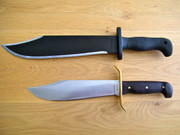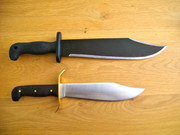Beiträge von kwakster
-
-
Wenn did Randall change the stainless from 440B to ATS34/154CM ?
-
-
-
After removing all the edge damage and restoring the full convex blade shape with 400 and 800 grit wet & dry using WD40 oil as a lubricant on a semi-hard rubber backing.
Removed the tiny burr with some 1.0 micron diamond paste on hard cardboard, and the new edge angle is +/- 26 degrees inclusive.
It's apex will whittle a chesthair from root to tip, and was also tested by whittling an old piece of wooden cutting board, which it does just fine.
The swedge was recut using 2 diamond files.
(You can click 2x on each pic for a bit more detail) -
A while ago i bought this what i think is a nice little knife, and although it looks quite a bit like the well known Woodcraft model it wasn't made by Marble's USA.
Now in 1916 Webster Marble received a patent on his Woodcraft knife which lasted around 20 years, but because the model became widely populair other manufacturers had similar models made outside the US to get around the patent, often in Solingen Germany.The blade on my knife has no markings and the pommel doesn't have the mushroom shape like many Woodcraft models.
Based on this and the typical handle construction with 2 stag panels held together by brass rivets my best guess is that it's a Solingen made Woodcraft copy from the 1920's or 1930's or who knows ?
Later seems unlikely, first because of the war and after that various US manufacturers could make as many Woodcraft type knives in the US as the market could bear since the patent had already ran out.The specimen i have is a well made knife with very hard steel (noticeably harder than my F.Dick basterd file no.1), and i'm currently in the process of making it functional again.
It definitely has had a hard life with many sharpening attempts, and somewhere in time a previous owner even used the pommel as a hammer, which dented it quite badly and also got it stuck on the threaded tang.This is how i received the knife:
On YouTube i found this clip by German collector Jake vd Ibach where he shows a Fahrtenmesser made by Solingen manufacturer Carl Friedrich Ern, and based on the type and sequence, type and color of the spacers as well as the shape of the pommel on his knife i'm starting to think that my knife was also made by CF Ern.
What do you guys think ?
-
-
Heute angekommen bei mir in die Niederlande dieses vintage Puma 8101 Texas Bill Wurf & Fahrtenmesser, Eigentum eines Deutsches TF-Mitglied.
Mal sehen ob etwas TLC das Messer gut bekommen wird.Ich vermute das die Text "Adjustiert" zusammen mit ein Adler (?) auf das kleine Knopchen etwas mit dem Drittes Reich zu tun hat, aber vielleicht weiss einer von euch mehr davon ?
-
Muss es eine Maschine sein oder darf es auch ein manuelles Gerat sein ?
-
Um was fur Messer geht es ?
-
-
-
Did it's twin brother a while ago:
[mit Bildern] Vintage Marble's Woodcraft fixed blade
The difference is that on that knife the goal was to re-establish the original full convex zero grind blade geometry while at the same time saving as much of the old patina as i could.
The apex of both knives lies around 25 degrees inclusive. -
-
Restoration projects like these can be very rewarding, as not only do you get to bring pieces of knife history back to life, it's quite useful to practice your skills, plus it pays for itself as generally i use the proceeds of the sale of a restored knife to buy other oldies that could use some work.
Currently busy with this small Marble's Woodcraft fixed blade, probably made in the late 1920's or early 1930's. -
The owner of the Takamura R2 just sent me the link to this clip, in which he uses a grape to test the new edge:
-
Right hand Takamura R2 Gyuto 210 mm from a local Chef, who got it as a birthday present from his wife.
The knife has already been used for two months in the commercial kitchen and it was time for it's first resharpening, which i did yesterday on a Paper Wheel with 15 micron diamond compound and then deburred on a second Paper Wheel with 0.25 micron diamond compound.
The idea was to make an edge that would do both slicing & pushcutting well, and also to remove as little steel as possible from the fine and thin R2/SG2 blade @ 63-64 HRC.
The new edge measures +/- 20 degrees inclusive and can whittle a chest hair from root-to-tip at about 4 centimeters from the point of holding, and after a few test cuts into a old piece of beechwood cutting board.I took these pics with an old Ipad and actually wanted to erase them again as being not good enough until i enlarged the last picture twice.
At first i thought i saw small dirt spots on the new bevel, but those tiny white specks were actually the sliced off peaks of the micro-dot structure on the inside of the flimsy plastic blade protector sleeve. -
Recently the second Kohetsu was returned to me for sharpening.
The knife had been used about 3 days a week quite intensively for 6 months, and was touched up from time to time by the owner on an MDF strop coated with 1.0 micron diamond paste.
When i received the knife back i could see on the edge an area of about half an inch where it reflected a bit of light, i was told probably due to some sand particles that sometimes remain in vegetables.
The rest of the edge could still easily shave clean the hair on the back of my hand on skin level. -
The Cold Steel Black Bear machete is something of a crossbreed between a short machete & a bowie knife, and imo because of the untapered fairly thick & rigid blade and the resulting overall weight this model is better suited for chopping branches and smaller trees than light brush or brambles.
These machetes are manufactured for Cold Steel by Lasher Tools in South Africa from very well hardened 1055 carbon steel that is extremely tough.
Not only are they practically indestructible, but once resharpened they will also take & hold an almost unexpected good edge.
Straight from the factory they are however completely blunt or not even apexed, and what "edge" there is is also burnt due to uncooled and sloppy machine sharpening.
It will take some time and elbow grease to put on a good convex edge that will showcase the true quality of these blades, but i have found that to be more than worth it.
The original polypropylene handle on this Black Bear was both too thick and too slick for my taste, so out came the wood rasp again.
The difference in handling & grip after the contouring with the fuzzy finish is literally night and day, and the best part is that you only need one simple handtool to do it.
Very useful piece of equipment with a good price to quality ratio for bushcraft, garden maintenance, and last but not least home defense.Mods on this one:
- Polypropylene handle contoured and "fuzzy finished"
- Factory edge slightly reprofiled & resharpened to an armhair shaving convex edge (apex now lies between 30 and 35 degrees inclusive)
- Factory swedge slightly reprofiled & resharpened to an armhair shaving convex edge (apex now lies between 35 and 40 degrees inclusive)Specs:
Overall length: 45,2 cm (17.8 inches)
Blade length: 30,8 cm (12.13 inches)
Blade thickness: 2,89 mm
Steel type: 1055 carbon steel with baked-on anti-rust coating
Handle material: polypropylene plastic
Weight 510 grams
Sheath: Cor-Ex with tip protector -

















